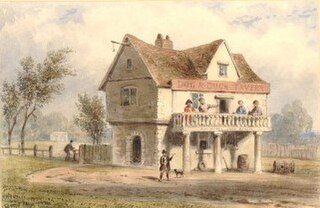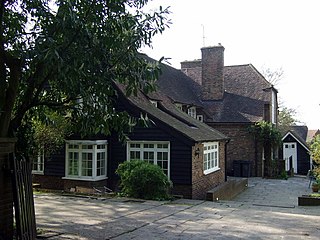
Hampstead is an area in London, England, which lies 4 miles (6 km) northwest of Charing Cross, forming the northwest part of the London Borough of Camden, a borough in Inner London. It borders Highgate and Golders Green to the north, Belsize Park to the south and is surrounded from the northeast by Hampstead Heath, a large, hilly expanse of parkland.

Highgate is a suburban area of north west London at the northeastern corner of Hampstead Heath in the London Boroughs of Camden, Islington and Haringey, 4+1⁄2 miles north-northwest of Charing Cross.

George SteevensFRS was an English Shakespearean commentator.
The Kit-Cat Club was an early 18th-century English club in London with strong political and literary associations. Members of the club were committed Whigs. They met at the Trumpet Tavern in London and at Water Oakley in the Berkshire countryside.

The World's End is a pub and music venue at 174 Camden High Street in Camden Town, London, England, just south of Camden Town tube station with an additional branch at Finsbury Park, 23 Stroud Green Rd, London. It is a long established business, formerly known as Mother Red Cap or Mother Damnable's.

The Spaniards Inn is a historic pub on Spaniards Road between Hampstead and Highgate in London, England. It lies on the edge of Hampstead Heath near Kenwood House. It is a Grade II listed building, dating back to the 16th century.

Samuel Hoare Jr was a wealthy British Quaker banker and abolitionist born in Stoke Newington, then to the north of London in the county of Middlesex. From 1790, he lived at Heath House on Hampstead Heath. He was one of the twelve founding members of the Society for the Abolition of the Slave Trade.

The Dog and Duck was a tavern built upon St George's Fields in London in the 17th century. It was named after the sport of duck-baiting, that took place in adjacent wetland. In the 18th century its gardens were used as a spa but, by the 1770s, with spas no longer fashionable, it declined into a rowdy location for concerts. The magistrates refused to renew its licence, despite protracted legal disputes, and it closed in 1799. The building was then used as a School for the Indigent Blind and demolished in 1812, when the new Bethlem Hospital was built upon the site. That building is now used by the Imperial War Museum.

Heath House is a historic mansion on Hampstead Heath. It is Grade II* listed and located on Hampstead's North End Way in the London Borough of Camden. It is located at the highest point upon leaving the capital, about four miles north of Trafalgar Square. The Hampstead War Memorial stands in front of the house.

Wyldes Farm is a Grade II* listed former farmhouse in the hamlet of North End, Hampstead, in the London Borough of Barnet, NW11.

The Flask is a Grade II listed public house at 74–76 Highgate West Hill, Highgate, London. According to the 1936 Survey of London, a pub known as The Flask has stood on this spot since "at least as early as 1663". The present buildings probably date from the early 18th century, and were partially rebuilt in about 1767 by William Carpenter. A Manorial court met there in the eighteenth century. The Flask is currently owned and operated by the London-based Fuller's.

The Flask is a Grade II listed public house at 14 Flask Walk, Hampstead, London, on the site from where the trade in Hampstead mineral water was run, and which is mentioned in the eighteenth-century novel Clarissa. It has been owned by Young's Brewery since 1904.

The Magdala, also known as The Magdala Tavern or colloquially as simply The Magy, is a pub on South Hill Park in Hampstead, north London. Named after the British victory in the 1868 Battle of Magdala, it was the site of a notorious murder in 1955.

Holland House, originally known as Cope Castle, was an early Jacobean country house in Kensington, London, situated in a country estate that is now Holland Park. It was built in 1605 by the diplomat Sir Walter Cope. The building later passed by marriage to Henry Rich, 1st Baron Kensington, 1st Earl of Holland, and by descent through the Rich family, then became the property of the Fox family, during which time it became a noted gathering-place for Whigs in the 19th century. The house was largely destroyed by German firebombing during the Blitz in 1940 and today only the east wing and some ruins of the ground floor and south facade remain, along with various outbuildings and formal gardens. In 1949 the ruin was designated a grade I listed building and it is now owned by the Royal Borough of Kensington and Chelsea.

Francis "Frank" John Potter (1871-1948) was a British architect who designed the new Hampstead Observatory and the Carlton Tavern in Kilburn, London.

The Greene Man is a public house in London's Euston Road. It was formerly known as the Green Man and before that, the Farthing Pie House or Pye House as mutton pies could be bought there for a farthing. When it was established in the 18th century, the area was rural and so the surroundings were farm fields and pleasure gardens. The place was then frequented by notable artists and writers including William Blake and Richard Wilson.

The Chalk Farm Tavern was a public house located in what is today Regent's Park Road in Primrose Hill, London.
Well Walk is a street in Hampstead, England in the London Borough of Camden. It runs southwestwards from Hampstead Heath to Flask Walk which then continues on towards the centre of Hampstead Village around the Hampstead tube station. It takes its name from the historic Hampstead Wells.

Flask Walk is a street in Hampstead in the London Borough of Camden. It runs eastwards from Hampstead High Street to a junction with Well Walk and New End Square. It is primarily residential but the western end of the street is a pedestrianised alley featuring commercial properties. Hampstead tube station is located close to the junction with the High Street.

Heath Street is in Hampstead in the London Borough of Camden, part of the A502 road for much of its route. It runs from the centre of Hampstead Village northwards towards Hampstead Heath. By Jack Straw's Castle it divides into North End Way heading towards North End and Spaniards Road heading towards Hampstead Garden Suburb and Highgate via Hampstead Lane. Streets running off it include Church Row, New End, Holly Hill, Hampstead Grove and Hampstead Square.


















